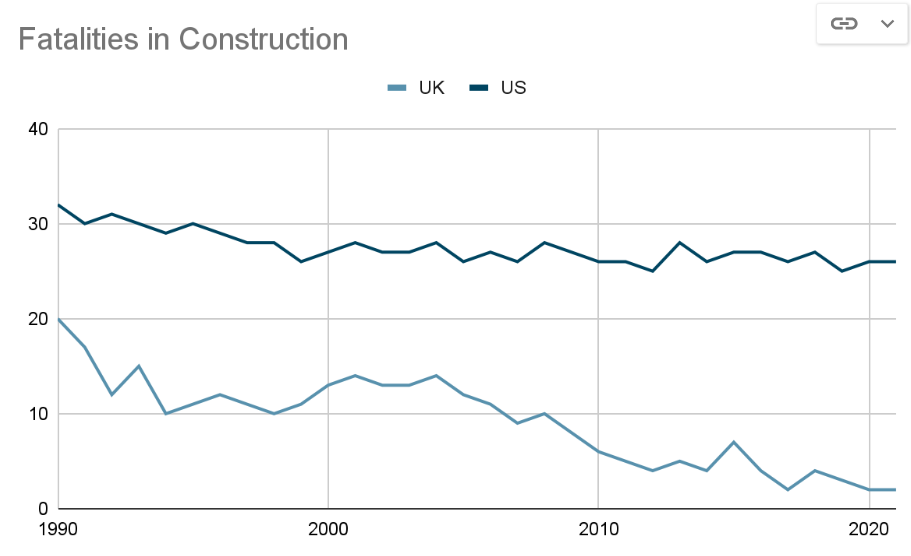The Most Dangerous Jobs in America in 2023
We all face risks every day of our lives. But some occupations are inherently more dangerous than others. Instinctively, you might have an idea what some of those jobs are. You might think firefighters, police officers and other first responders put their lives on the line to protect others. Yet surprisingly, these jobs are statistically nowhere near the most dangerous.
The following data is taken from 2021 statistics from the U.S. Bureau of Labor. When reading through the most dangerous jobs, it is worth keeping in mind that there were 5,190 fatal work injuries recorded in the United States in 2021. That works out at an average of 3.6 fatalities per 100,000 workers, and it puts the numbers in the right-hand column into context.
Dangerous Occupations
| Rank | Occupation | Fatalities per 100,000 employees |
| 1 | Logging and tree cutting | 82 |
| 2 | Fishing | 75 |
| 3 | Roofing | 59 |
| 4 | Miner | 50 |
| 5 | Commercial pilot | 48 |
| 6 | Construction — iron and steel work | 36 |
| 7 | Driver | 29 |
| 8 | Refuse collector | 28 |
| 9 | Construction — other | 26 |
| 10 | Electrical power line installation | 22 |
We will look at some of these jobs in more detail in just a moment. But first, a general observation is that these are mostly blue-collar jobs. They don’t jump out at us as dangerous, and we see construction workers, truck drivers, and refuse collectors every day without it occurring to us that they are around ten times more likely to die at work than the average American.
Likewise, with the exclusion of commercial pilots, who represent something of an outlier, these are not jobs where individuals are being richly rewarded for putting their lives on the line. The median salary is around the $40,000 mark, significantly below the median salary for the U.S.A as a whole, which is about $55,000.
Types of Injury and Accident
To get a feeling for why these occupations are so much more dangerous to life and limb than average, it will help to understand the types of workplace accidents that are most common. Here, we will look at both fatal and non-fatal incidents.
| Non-fatal injuries and illness | Fatal injuries and illness | ||
| Type | Number of cases | Type | Number of cases |
| Falls on same level | 127,680 | Road accidents | 1,253 |
| Overexertion in lifting or lowering | 79,360 | Falls from height | 680 |
| Falls from height | 49,250 | Homicide | 481 |
| Struck by falling object | 45,760 | Drugs and alcohol | 464 |
| Overexertion in pushing or pulling | 42,320 | Suicide | 236 |
| Struck by stationary object | 35,130 | Struck by falling object | 227 |
| Injured by handheld object | 32,690 | Struck by powered vehicle | 169 |
| Slips and trips | 30,130 | Inhale harmful substance | 72 |
| Repetitive bending, crawling, twisting | 29,550 | Slips and trips | 57 |
| Caught in or compressed by object | 29,270 | Explosions | 43 |
There are a couple of things that really stand out here.
- Road accidents represent by far the highest number of workplace fatalities. In fact, almost twice as many workers are killed on America’s roads as from the second highest cause of fatality, falling from height.
- When it comes to non-fatal accidents and injuries, the picture is very different, and two of the top three causes of fatalities are not even in the top ten. Here, falls, over-exertion, and impact with objects, either falling or stationary, are the top causes of injury.
Manual Labor Is Dangerous Work
There are a few obvious outliers in the above lists. We have already pointed out that commercial pilot is the only high-risk job that would not be considered “blue collar;” the median salary here is more than double the average across the other jobs on the list.
Likewise, when we look at homicide, suicide, or incidents relating to drugs and alcohol, we see they are as likely to happen to lawyers and real estate agents as they are to construction workers or car mechanics. The rest, however, are typically related to manual labor, where individuals are more likely to face exposure to heights and falling objects or to over exert themselves lifting and carrying heavy objects.
A Closer Look at the Most Dangerous Jobs
1) Driving
America’s highways and interstates can be dangerous places. Intuitively, we all know that. We’ve all been involved in at least a minor fender bender at some time or other, and we all know at least one person and probably more who have been involved in a serious accident or lost their lives on the road.
When you really stop to think about it, that demonstrates just how dangerous driving can be. If you take risks and drive dangerously, it is only a matter of time before you come to grief. But even if you are a cautious and defensive driver, the law of averages states that you will encounter either bad conditions, vehicle failure, a dangerous driver, or just plain bad luck sooner or later.
The more time you spend on the road, the higher that probability gets, so when we think about people who drive for a living, whether it is big rigs, smaller delivery vehicles, or maybe a taxi or Uber, there is a sense that they are almost playing Russian roulette with their own lives every time they get behind the wheel. Little wonder, you might say, that the U.S. is facing a professional driver shortage right now.
2) Roofing and general construction
Roofing and general construction combined to produce the highest number of fatalities per 100,000 workers in the U.S. in 2021. When we scan through the top causes, we can surmise that falling from height and being struck by falling objects are likely to be the most common causes. These, combined with falls and over-exertion, are also common causes of work-related injuries that are not fatal but that can have a serious impact on a worker’s life and ability to earn.
Unlike road accidents, which happen on the public highway, these accidents all take place within the confines of a construction site. It raises the question of whether the U.S. construction industry could be doing more to protect their workforce, particularly when you compare U.S. construction accident statistics with those in other nations of the world.
| Construction fatalities per 100,000 workers per year | |
| Moldova | 45 |
| Mexico | 32 |
| U.S.A | 26 |
| Canada | 20 |
| Global average | 10.2 |
| France | 4 |
| UK | 3 |
| Singapore | 2 |
| Germany | 1 |
In short, you are more than eight times more likely to die working on a construction site in the U.S. than on one in the UK. That sounds incredible, but it is a gap that has been steadily growing over the past 30 years.

Fatalities in construction — per 100,000 workers
For the past 50 years, U.K. construction sites have been safer places to work than U.S. ones. There is a similar pattern if we were to look at the number of non-fatal accidents. But over the past 20 years in particular, we can see that legislative and regulatory changes have had a profound impact on improving worker safety in the UK, whereas, in the U.S., the number of injuries and fatalities has remained approximately the same.
Improving the Safety of U.S. Construction Sites
So what lessons can the U.S. construction industry learn from the UK to reduce injuries and deaths from falls, slips, and heavy objects being dropped? To look for an answer, let’s examine some of the measures that the UK has taken over the past 30 years.
- Health and safety risk assessments before any project gets underway, introduced in 1992
- Mandatory use of PPE introduced in 1993
- Dedicated health and safety representatives for all work sites from 1996
- Construction, Design, and Management regulations mandate the inclusion of safety considerations at the design stage, introduced in 2015
- Tougher fall protection rules under the UK HSE than those enforced by OSHA
- A more stable workforce, with more experienced workers who take fewer risks
What we are seeing is a range of both regulatory and cultural differences in the way that construction sites operate. OSHA is not going to change overnight into something that mirrors the UK regulator. That’s probably a good thing, as to do so would paralyze the industry.
However, a company’s most valuable asset is its people. Construction businesses need to take a close look in the mirror to identify ways they can better protect its workforce, and taking inspiration from across the pond seems a good way to start. They have shown that falling from height, slipping on spills, or being struck by falling building materials are all events that can be, if not entirely eliminated, drastically reduced with basic health and safety practices.
Reducing Fatalities on America’s Roads
We identified roads and construction sites as the two most dangerous working environments. As we intimated earlier, it is easier to make meaningful changes to reduce injuries and save lives in construction because it is a closed environment — at least, it should be.
Protecting and preserving those who spend hours every day behind the wheel is a more complex proposition. There are so many external factors that many experts feel the public highway will always be a dangerous place. Yet once again, spending time on the road in the U.S. is more likely to end in death than doing so in any other developed country.

There are measures that employers and individuals can take to make it less so.
1) Champion defensive driving
We’ve all seen those dashcam videos on TV and the internet. They are a perfect training tool in terms of what not to do when driving defensively, and that’s just looking at the behavior of the camera vehicle. Nearly 80 percent of the incidents shown would not be incidents at all if the car or truck with the dashcam drove defensively.
It’s a simple concept that can best be described as assuming every other road user is not going to make rational decisions. Other road users are wild cards, so be aware of what is going on around you and use the brake instead of the horn. It might not make such exciting video footage but it could save a life, or at least a lot of hassle and an insurance claim.
2) Changing attitudes toward speed
There has been plenty of discussion about speed limits, but reducing them is not necessarily the answer. Germany still has hundreds of miles of autobahn that are unrestricted, yet it has fewer fatalities per million than most, including its immediate neighbors.
Fatal speed-related accidents in the U.S. typically involve vehicles traveling well over the speed limit — suggesting that changing that limit is immaterial. What could make a difference is rationalizing the nation’s speed limits so that they make sense and then rigorously enforcing them. In Germany, drivers might travel at well over 100 mph on unrestricted stretches of autobahn. But when they enter an area with a speed limit, they observe it, and there are automatic cameras on gantries that will photograph offenders and issue fines by mail with no human involvement. In the UK, drivers can travel at 60mph on narrow country roads in rural areas. But in towns and villages, limits of 30 or even 20 past schools are enforced and followed without question.
3) NRSS Action
The Nationwide Roadway Safety Strategy (NRSS) is taking a joined-up approach to mitigate human driving errors, encourage safer behavior, account for injury tolerances, and facilitate safer travel for more vulnerable road users. Initiatives are in place for all types of roads, from freeways to state roads to urban residential streets. This will serve for the long-term benefit of all, but particularly those who spend all day every day on America’s road network.


